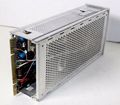DC503: Difference between revisions
Jump to navigation
Jump to search
No edit summary |
No edit summary |
||
| Line 1: | Line 1: | ||
{{TM500 | mfg=Tektronix | type=DC503 | function=100 MHz, 7-digit frequency counter | class=counter | image=Tek-dc503-front.jpg | introduced=1972 | discontinued= | {{TM500 | mfg=Tektronix | type=DC503 | function=100 MHz, 7-digit frequency counter | class=counter | image=Tek-dc503-front.jpg | introduced=1972 | discontinued=1981 | ||
|designers=Roland Crop;Jim Geddes | |designers=Roland Crop;Jim Geddes | ||
|manuals= | |manuals= | ||
| Line 8: | Line 8: | ||
* [[Media:TM_9-6625-474-14.pdf|DC503A Military Manual]] | * [[Media:TM_9-6625-474-14.pdf|DC503A Military Manual]] | ||
* [[Media:Tek_DC503_FCP_1977-02-18.pdf|Tektronix DC503 Factory Calibration Procedure]] (OCR) | * [[Media:Tek_DC503_FCP_1977-02-18.pdf|Tektronix DC503 Factory Calibration Procedure]] (OCR) | ||
}} | }}. It was [[introduced in 1972]] at the launch of the TM500 system, and superseded by the [[DC503A]] in 1981. | ||
Opt.01 is an [[wikipedia:Crystal oven|OCXO]] for improved stability. | Opt.01 is an [[wikipedia:Crystal oven|OCXO]] for improved stability. | ||
{{BeginSpecs}} | {{BeginSpecs}} | ||
{{Spec | Frequency Range | 0.1 Hz (AC coupled: 10 Hz) to 100 MHz }} | {{Spec | Frequency Range | 0.1 Hz (AC coupled: 10 Hz) to 100 MHz }} | ||
| Line 26: | Line 26: | ||
{{Spec | Error | ≤ ±5 × 10<sup>-7</sup> from 0 °C to +50 °C (after oven warm-up) }} | {{Spec | Error | ≤ ±5 × 10<sup>-7</sup> from 0 °C to +50 °C (after oven warm-up) }} | ||
{{Spec | Aging | ≤ ±1 × 10<sup>-7</sup> per month }} | {{Spec | Aging | ≤ ±1 × 10<sup>-7</sup> per month }} | ||
{{EndSpecs}} | {{EndSpecs}} | ||
| Line 40: | Line 31: | ||
* [[Media:670-3300-00.zip|Divide-by-5 circuit board gerbers 670-3300-00]] (ZIP) | * [[Media:670-3300-00.zip|Divide-by-5 circuit board gerbers 670-3300-00]] (ZIP) | ||
==Rear interface | ==Rear interface== | ||
<small> | <small> | ||
* 14A − 1 MHz clock out | * 14A − 1 MHz clock out | ||
| Line 58: | Line 49: | ||
==Links== | ==Links== | ||
{{Documents|Link=DC503}} | {{Documents|Link=DC503}} | ||
==Pictures== | ==Pictures== | ||
<gallery> | <gallery> | ||
Tek-dc503-front.jpg | DC503 | Tek-dc503-front.jpg | DC503 | ||
| Line 72: | Line 61: | ||
Tek dc503 34.jpg|DC503 | Tek dc503 34.jpg|DC503 | ||
Tek dc503 on.jpg|DC503 | Tek dc503 on.jpg|DC503 | ||
</gallery> | </gallery> | ||
==Components== | ==Components== | ||
{{Parts|DC503}} | {{Parts|DC503}} | ||
Revision as of 04:46, 1 December 2023
The Tektronix DC503 is a 100 MHz, 7-digit frequency counter plug-in for the TM500 system. . It was introduced in 1972 at the launch of the TM500 system, and superseded by the DC503A in 1981.
Opt.01 is an OCXO for improved stability.
Key Specifications
| Frequency Range | 0.1 Hz (AC coupled: 10 Hz) to 100 MHz |
|---|---|
| Impedance | 1 MΩ paralleled by approx. 20 pF |
| Sensitivity | 300 mVp-p sinewave times attenuation to 100 MHz |
| Max Input Voltage | 1× Atten: 50 V @ ≤2 kHz, derate −20 dB/decade to 10 MHz; 10 V @ 10 kHz to 25 MHz, derate −20 dB/decade to 50 MHz; 5 V @ 50 MHz to 100 MHz |
| Max Input Voltage | 10×/100× Atten: 500 V @ ≤2 MHz, derate -20 dB/decade to 100 MHz |
| — Standard time base — | |
| Frequency | 1 MHz ± 1 × 10-7 at cal |
| Error | ≤ ±1 × 10-5 from 0 °C to +50 °C |
| Aging | ≤ ±1 × 10-5 per month |
| — Opt.01 OCXO time base — | |
| Frequency | 5 MHz ± 5 × 10-9 at cal |
| Error | ≤ ±5 × 10-7 from 0 °C to +50 °C (after oven warm-up) |
| Aging | ≤ ±1 × 10-7 per month |
Gerbers
Rear interface
- 14A − 1 MHz clock out
- 16A − CH A input (GND return on 17A)
- 17B − CH B input (GND return on 16B)
- 19B − Data good
- 19A − BCD output serial-by-digit (1)
- 20A − BCD output serial-by-digit (4)
- 20B − BCD output serial-by-digit (8)
- 21B − BCD output serial-by-digit (2)
- 22B/23B − Overflow out/overflow display disable in
- 24B/25B − Internal scan clock out/external scan clock in
- 25A − Time slot zero (TS0)
- 26A − Reset, in/out
- 27A − Internal scan clock disable
Links
Documents Referencing DC503
Pictures
-
DC503
-
DC503
-
DC503
-
DC503
-
DC503
-
DC503
-
DC503
Components
Some Parts Used in the DC503
| Part | Part Number(s) | Class | Description | Used in |
|---|---|---|---|---|
| 2N4249 | 151-0342-00 | Discrete component | Si PNP low-noise transistor | DC501 • DC502 • DC503 • DC503A • DC504 • DC504A • DC505 • DC505A • DC508 • DC508A • DC509 • DC510 |
| 2N4851 | 151-0504-00 • 151-0504-01 | Discrete component | silicon unijunction transistor | DC501 • DC502 • DC503 • DC503A • DC504 • DC505 • DC505A • DC508 • DC508A • LA501 • R1330 • 212 • 214 • 4002A • 4623 • 4631 • 4632 • 4633A • 4634 • 4701 • 4701R • 670-0696-01 • 670-1274-00 • 670-1981-00 • 670-1981-01 • 7D01 • 7D12 • 7L12 |








